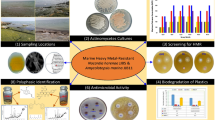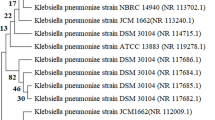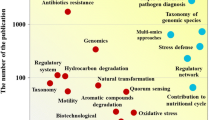Abstract
Highly arsenic resistant bacteria (27 isolates), which had a minimum inhibitory concentrations (MICs) for arsenite and arsenate of ⩾ 40 mM and > 400 mM, respectively, were isolated from tannery wastes and agricultural soils collected in Central Thailand. On the basis of the morphological, cultural, physiological and biochemical characteristics, and on the principal ubiquinone component and 16S rRNA gene sequence analyses, they were identified as nine isolates each ofKlebsiella (Groups 1 and 8) andAcinetobacter (Groups 2, 3 and 7), four isolates each ofPseudomonas (Groups 4 and 6) andComamonas (Group 5), and one isolate ofEnterobacter (Group 9). From these 27 isolates, only one isolate, A3-3 from the genusComamonas, appeared potentially capable of oxidizing arsenite to arsenate, as determined by silver nitrate staining of arsenite agar plates after colony growth.
Similar content being viewed by others
References
ATSDR — Agency for Toxic Substances and Disease Registry (2000). Toxicological Profile for Arsenic September, 2000. Prepared for the US Department of Health and Human Services by Syracuse Research Corporation.
Baïda N., Yazourh A., Singer E., Izard D. (2002).Pseudomonas grimontii sp. nov. Int. J. Syst. Evol. Microbiol., 52: 1497–503.
Baptiste P. (2000). Arsenic exposures during burning activities in battery assembly. Appl. Occupational Environ. Hygiene, 15: 664–666.
Barrow G.I., Feltham R.K.A. (1993). Cowan and Steel’s Manual for the Identification of Medical Bacteria, 3rd edn., Cambridge University Press, Cambridge.
Brierley J.A., Brierley C.L. (2001). Present and future commercial applications of biohydrometallurgy. Hydrometallurgy, 59: 233–239.
Cai L., Liu G., Rensing C., Wang G. (2009). Genes involved in arsenic transformation and resistance associated with different levels of arsenic-contaminated soils. BMC Microbiol., 9: 4. http://hdl.handle.net/2384/68295.
Clausen C.A. (2000). Isolating metal-tolerant bacteria capable of removing copper, chromium, and arsenic from treated wood. Waste Manage. Res., 18: 264–268.
Diliana D.S., Didier L., Florence L., Daniel A.E., Veneta L.G., Marie-Claire L. (2004). Microplate screening assay for the detection of arsenite-oxidizing and arsenate-reducing bacteria. FEMS Microbiol., 237: 249–253.
D’Imperio S., Lehr C.R., Breary M., McDermott TR. (2007). Autecology of an arsenite chemolithotroph: sulfide constraints on function and distribution in a geothermal spring. App. Environ. Microbiol., 73: 7067–7074.
DNREC — The Department of Natural Resources and Environmental Control (2002). Initial Investigation Report on Surface Soils, Wilmington Tannery Site 34 and 35 (The Asbury Gardens Apartments). January, 2002. Prepared for the Site Investigation and Restoration Branch by Stephen FJ.
Drancourt M., Bollet C., Carta A., Rousselier P. (2001). Phylogenetic analyses of Klebsiella species delineateKlebsiella and Raoultella gen. nov., with description ofRaoultella ornithinolytica comb. nov.,Raoultella terrigena comb. nov. andRaoultella planticola comb. nov. Int. J. Syst. Evol. Microbiol., 51: 925–932.
Eguchi N., Kuroda K., Endo G. (1997). Metabolites of arsenic induced tetraploids and mitotic arrest in cultured cells. Arch. Environ. Contam. Toxicol., 32: 141–145.
Felsenstein J. (1985). Confidence limits on phylogenies: an approach using the bootstrap. Evolution, 39: 783–791.
Hoffmann H., Stindl S., Stumpe A., Mehlen A., Monget D., Heesemann J., Schleifer K.H., Roggenkamp A. (2005). Description ofEnterobacter ludwigii sp. nov., a novelEnterobacter species of clinical relevance. Syst. Appl. Microbiol., 28: 206–212.
Huysmans K.D., Frankenberger W.T. Jr. (1990). Arsenic resistant microorganisms isolated from agricultural drainage water and evaporation pond sediments. Water Air Soil Pollut., 53: 159–168.
Joris M., Simon, S. (2006). Arsenate Reduction: Thiol cascade chemistry with convergent evolution. J. Mol. Biol., 362: 1–17.
Khan B.I., Jambeck J., Solo-Gabriele H.M., Townsent T.G., Cai Y. (2006). Release of arsenic to the environment from CCA-treated wood. 2. Leaching and speciation during disposal. Environ. Sci. Technol., 40: 994–999.
Komagata K., Suzuki K. (1987). Lipid and cell-wall analysis in bacterial systematics. Methods Microbiol., 19: 161–207.
Krumova K., Nikolvska M., Groudeva V. (2008). Isolation and identification of arsenic-transforming bacteria from arsenic contaminated sites in Bulgaria. Biotechnol. Biotechnol. EQ., http://www.diagnosisp.com/dp/ journals/view_pdf.php?journal_id=1&archive=1&issue_ id=18&article_id=492.
Kumar S.,Tamura K., Jakobson I.B., Nei M. (2001). MEGA 2: Molecular evolution analysis software. Bioinformatics, 17: 1244–1245.
Lett M.C., Paknikar K., Lihvremont D. (2001). In: Ciminelli V.S.T., Garcia O., Eds, Ion Hydrometallurgy-Fundamentals, Technology and Sustainable Development, Part B., Elsevier Science, N.Y.
Mateos L.M., Ordonez E., Letek M., Gil J.A. (2006).Corynebacterium glutamicum as a model bacterium for bioremediation of arsenic. Int. Microbiol., 9: 207–215.
Muller D., Lievremont D., Simeonova D.D., Hubert J.C., Lett M.C. (2003).Arsenite oxidase aox genes from a metal-resistant beta-proteobacterium. J. Bacterid., 185: 135–141.
NRC — National Research Council (1999). Arsenic in Drinking Water. National Academy Press, Washington, D.C.
Nemec A.,De Baere I.T., Tjernberg M., Vaneechoutte T J. K., Dijkshoorn. L. (2001).Acinetobacter ursingii sp. nov. andAcinetobacter schindleri sp. nov., isolated from human clinical specimens. Int. J. Syst. Evol. Microbiol., 51: 1891–1899.
Niggemyer A., Spring S., Stackebrandt E., Rosenzweig R.F. (2001). Isolation and characterization of a novel As(V)-reducing bacterium: implications for arsenic mobilization and the genusDesulfitobacterium. Appl. Environ. Microbiol., 67: 5568–5580.
Nishimori E., Kita-Tsukamoto K., Wakabayashi H. (2000).Pseudomonas plecoglossicida sp. nov., the causative agent of bacterial haemorrhagic ascites of ayu,Plecoglossus altivelis. Int. J. Syst. Evol. Microbiol., 50: 83–89.
Olson O.E., Sisson L.L., Moxon A.L. (1940). Absorption of selenium and arsenic by plants from soils under natural conditions. Soil Sci., 50: 115.
Oremland R.S., Stolz J.F. (2005). Arsenic, microbes and contaminated aquifer. Trends Microbiol., 13: 45–49.
Pepi M., Volterrani M., Renzi M., Marvasi M., Gasperini S., Franchi E., Focardi S.E. (2007). Arsenic- resistant bacteria isolated from contaminated sediment of the Orbetello Lagoon, Italy, and their characterization. Appl. Microbiol., 103: 2299–2308.
Quéméneur M., HeinrichSalmeron A., Muller D., Lièvremont D., Jauzein M., Bertin P.N., Garrido F., Joulian C. (2008). Diversity surveys and evolutionary relationships ofaoxB genes in aerobic arsenite-oxidizing bacteria. Appl. Environ. Microbiol., 74 (14): 4567–4573.
Santini J.M., vanden Hoven R.N. (2004). Molybdenum-containing arsenite oxidase of the chemolithoautotrophic arsenite oxidizer NT-26. J. Bacteriol., 186: 1614–1619.
Saito H., Miura K.I. (1963). Preparation of transforming deoxyribonucleic acid by phenol treatment. Biochim. Biophys. Acta, 72: 619–629.
Saitou N., Nei M. (1987). The neighboring-joining method: a new method for reconstruction phylogenic trees. Mol. Biol. Evol., 4: 406–425.
Smedley P.L., Kinniburgh D.G. (2002). A review of source, behaviour and distribution of arsenic in natural waters. Appl. Geochem., 17: 517–568.
Srinath T., Verma T., Ramteke P.W., Garg S.K. (2002). Chromium(VI) biosorption and bioaccumulation by Chromate resistant bacteria. Chemosphere, 48: 427–435.
Takeuchi M., Kawahata H., Gupta L.P., Kita N., Morishita Y., Komai T. (2007) Arsenic resistance and removal by marine and non-marine bacteria. J. Biotechnol., 127: 434–442.
Tamaoka J., Ha D.M., Komagata K. (1987). Reclassification ofPseudomonas acidovorans den Dooren de Jong 1926 andPseudomonas testosteroni Marcus and Talalay 1956 asComamonas acidovorans comb. nov. andComamonas testosteroni comb. nov., with an emended description of the genusComamonas. Int. J. Syst. Bacteriol., 37: 52–59.
Tanasupawat S., Thawai C., Yukphan P., Moonmangmee D., Itoh T, Adachi O., Yamada Y. (2004).Gluconobacter thailandicus sp. nov., an acetic acid bacterium in the α-proteobacteria. J. Gen. Appl. Microbiol., 50: 159–167.
Thompson J.D., Gibson T.J., Plewniak F., Jeanmougin F., Higgins D.C. (1997). The CLUSTAL_X windows interface: Flexible strategies for multiple sequence alignment aided by quality analysis tools. Nucleic Acids Res., 25: 4876–4882.
Tseng C.H. (2004). The potential biological mechanisms of arsenic-induced diabetes mellitus. Toxicol. Appl. Pharmacol., 197: 67–83.
Tsuruta T. (2004). Cell-associated adsorption of thorium or uranium from aqueous system using various microorganisms. Water Air Soil Pollut., 159: 35–47.
Walsh L.M., Keeney D.R. (1975). Arsenic Pesticides. In: Woolson E.A., Ed., Amer. Chem. Soc. Symp. Ser 7, Chem. Soc. Washington, D.C, pp. 35–52.
Walton F.S., Harmon A.W., Paul D.S., Drobna Z., Patel Y.M., Styblo M. (2004). Inhibition of insulin-dependent glucose uptake by trivalent arsenical: possible mechanism of arsenic-induced diabetes. Toxicol. Appl. Pharmacol., 198: 424–433.
Wauters G., De Baere T., Willems A., Falsen E., Vaneechoutte M. (2003). Description ofComamonas aquatica comb. nov. andComamonas kerstersii sp. nov. for two subgroups ofComamonas terrigena and emended description ofComamonas terrigena. Int. J. Syst. Evol. Microbiol., 53: 859–862.
Author information
Authors and Affiliations
Corresponding author
Rights and permissions
About this article
Cite this article
Chitpirom, K., Akaracharanya, A., Tanasupawat, S. et al. Isolation and characterization of arsenic resistant bacteria from tannery wastes and agricultural soils in Thailand. Ann. Microbiol. 59, 649–656 (2009). https://doi.org/10.1007/BF03179204
Received:
Accepted:
Issue Date:
DOI: https://doi.org/10.1007/BF03179204




